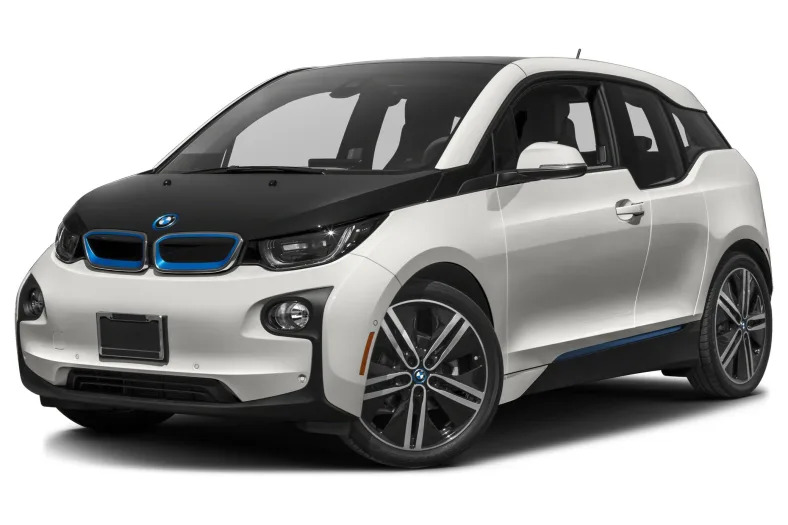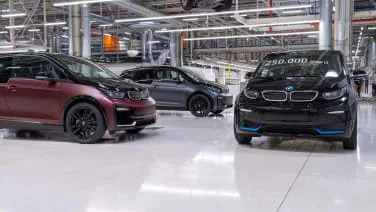2017 BMW i3
The BMW i3 is an environmental-radical showcase of a car with a unique persona. It's expensive for its small size, but there is genius to this little car, in the way it calms and soothes the driver with its electric powertrain, the way it takes the stress out of city driving and puts some fun in, while being the most energy-efficient car sold in the U.S. The hatchback styling is distinctive and daring, unlike any other car. The i3 is four years old but doesn't seem like it, because there are so few of them on the road.
Supermodels' names have been attached to the three BMW i3 models: Mega, Giga and Tera. But as forward-thinking as these green sisters may be, they're already outdated; that's how it goes in a world that moves at the speed of light. The far more affordable and prosaic Chevrolet Bolt EV came out with an unbeatable 240 miles of range.
So for 2017, the BMW i3 is available with more mileage. That available with phrase means it's an option costing $1200. A new lithium iron battery with 33 kilowatt hours yields 114 all-electric miles, a lot more than the 81 miles from the i3 with the standard 22-kilowatt-hour battery.
The i3 can run on gas when the electricity goes flat. That's an option too. For 2017, the gas tank on the i3 with the backup engine has been increased to 2.4 gallons from 1.9, adding two quarts' worth of miles to the overall range. The available engine is a two-cylinder 650cc range-extending (REx) engine, making 38 horsepower and 40 pound-feet of torque. It's clever, in its pursuit of fuel mileage. The engine doesn't power the wheels, but rather a generator that charges the battery. Using electric and fuel, the car's range reaches 150 miles. The engine costs another $4700 over the $1200 for the bigger battery.
With the weaker 22-kilowatt-hour battery, the i3 is rated at 124 MPGe. The 33-kW battery with greater range only scores 118 MPGe, because that battery takes more energy to charge. Mile Per Gallon Equivalent unit, or MPGe, measures how far a car can run on electricity, while using the amount of energy in a gallon of gas.
The i3 also has an available Combined Charging System, a strong 7.4 kwh (compare to Nissan Leaf's 6.6), which uses a quick-charging 240-volt port. It can charge the 22-kilowatt battery in 3 1/2 hours, and the 33-kilowatt battery in 4 1/2 hours, compared to as much as 16 hours with a standard 110-volt outlet. Installing the 240-volt BMW station at home can be done easily by an electrician. Only one problem with the option: BMW uses its own standard, incompatible with the vast majority of public charging stations. The good news is that all charging stations being built today are “dual-standard,” with two cables, so the newer stations will accept all electric cars.
The i3 hasn't been crash tested, but it's built like an Indy car, with a plastic body …
Full Review
Full Review
The hatchback styling is distinctive and daring, unlike any other car. The i3 is four years old but doesn't seem like it, because there are so few of them on the road.
Supermodels' names have been attached to the three BMW i3 models: Mega, Giga and Tera. But as forward-thinking as these green sisters may be, they're already outdated; that's how it goes in a world that moves at the speed of light. The far more affordable and prosaic Chevrolet Bolt EV came out with an unbeatable 240 miles of range.
So for 2017, the BMW i3 is available with more mileage. That available with phrase means it's an option costing $1200. A new lithium iron battery with 33 kilowatt hours yields 114 all-electric miles, a lot more than the 81 miles from the i3 with the standard 22-kilowatt-hour battery.
The i3 can run on gas when the electricity goes flat. That's an option too. For 2017, the gas tank on the i3 with the backup engine has been increased to 2.4 gallons from 1.9, adding two quarts' worth of miles to the overall range. The available engine is a two-cylinder 650cc range-extending (REx) engine, making 38 horsepower and 40 pound-feet of torque. It's clever, in its pursuit of fuel mileage. The engine doesn't power the wheels, but rather a generator that charges the battery. Using electric and fuel, the car's range reaches 150 miles. The engine costs another $4700 over the $1200 for the bigger battery.
With the weaker 22-kilowatt-hour battery, the i3 is rated at 124 MPGe. The 33-kW battery with greater range only scores 118 MPGe, because that battery takes more energy to charge. Mile Per Gallon Equivalent unit, or MPGe, measures how far a car can run on electricity, while using the amount of energy in a gallon of gas.
The i3 also has an available Combined Charging System, a strong 7.4 kwh (compare to Nissan Leaf's 6.6), which uses a quick-charging 240-volt port. It can charge the 22-kilowatt battery in 3 1/2 hours, and the 33-kilowatt battery in 4 1/2 hours, compared to as much as 16 hours with a standard 110-volt outlet. Installing the 240-volt BMW station at home can be done easily by an electrician. Only one problem with the option: BMW uses its own standard, incompatible with the vast majority of public charging stations. The good news is that all charging stations being built today are “dual-standard,” with two cables, so the newer stations will accept all electric cars.
The i3 hasn't been crash tested, but it's built like an Indy car, with a plastic body …
Hide Full Review
Retail Price
| Engine | |
| MPG | 137 City / 111 Hwy |
| Seating | 4 Passengers |
| Transmission | 1-spd auto |
| Power | 170 @ 4800 rpm |
| Drivetrain | rear-wheel |
| Curb Weight | 2,866 - 3,234 lbs |





